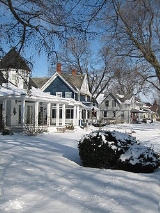
Sycamore Historic District
Encyclopedia
The Sycamore Historic District is a meandering area encompassing 99 acres (400,639.1 m²) of the land in and around the downtown of the DeKalb County, Illinois
, county seat, Sycamore
. The area includes historic buildings and a number of historical and Victorian
homes. Some significant structures are among those located within the Historic District including the DeKalb County Courthouse
and the Sycamore Public Library
. The district has been listed on the National Register of Historic Places since May 2, 1978.
There are over 200 properties within the irregular boundaries of the Sycamore Historic District. Of those, 187 are considered contributing properties to the historic district, and 22 are non-contributing. Of all of the district's homes and buildings 75% fit within the historic district concept. Some of the major structures include several prominent Queen Anne style mansions, the Sycamore library, the DeKalb County Courthouse, and dozens of mid to late 19th century houses.
The field surveyor who traveled to Sycamore in 1973 found a large number of late 19th and 20th century examples of architecture that he recommended the establishment of a historic district. The mayor of Sycamore then appointed a citizens' committee to assist the state with the work involved in listing the district.
The residential areas within the district achieved their maturity before 1900, though Sycamore has grown considerably from the 3,330 or so that lived there from about 1900 until the 1970s most of the historic district remains intact as it was organized in 1978.
) to the west until the 300 block. Somonauk Street is included through its 900 block. In addition section of Locust, Maple and California Streets are within the Sycamore Historic District. Other east/west streets also have portions included in the district, these are: Elm, High, Ottawa, Waterman and Lincoln.
The boundaries were drawn up by Robert Wagner, a Chicagoan who worked as a National Register assistant with the Illinois Department of Conservation. Wagner drew up the boundaries on the basis of "visual integrity.". This led to an irregular pattern of inclusion for the Sycamore Historic District. Often one side of the street will be in the district while the other side will not. In other cases, such as with the library or the U.S. Post Office
an arbitrary line was drawn with the sole purpose of including a specific structure.
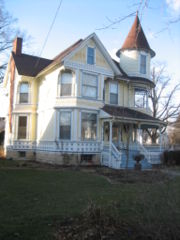 The hodge podge of architectural styles that mingle in the Sycamore Historic District begins with Greek Revival structures which date from Sycamore's foundation in the mid to late 1830s, also the heyday for that particular style. These structures are the oldest surviving within the district. After the Civil War
The hodge podge of architectural styles that mingle in the Sycamore Historic District begins with Greek Revival structures which date from Sycamore's foundation in the mid to late 1830s, also the heyday for that particular style. These structures are the oldest surviving within the district. After the Civil War
other styles began to dot the landscape in and around downtown Sycamore, Illinois
. Styles such as Italianate, Gothic Revival and Queen Anne can be found throughout the neighborhood. Government buildings and commercial buildings offer prime examples of Classical Revival architecture, a style showcased by the ornate DeKalb County Courthouse, Sycamore Public Library, U.S. Post Office and The National Bank & Trust Co. building. The current Sycamore Center, in the 300 block of State Street and once known as the Daniel Pierce Block, also exhibits. Classical Revival architecture.
Of the 226 properties within the Sycamore Historic District 40 are identified as "strongly contributing" to the overall character of the district. Twenty-one of those are ranked as the most significant structures in the district. The majority of the rest of the buildings date from 1860-1900.
 Sycamore Historic District includes a combination of residential, commercial, government and religious buildings. A number of Victorian homes along Main Street are enclosed in the historic district as well as a number of buildings in downtown Sycamore. South of the courthouse are other homes included in the district, each important structure is marked with a plaque near the sidewalk.
Sycamore Historic District includes a combination of residential, commercial, government and religious buildings. A number of Victorian homes along Main Street are enclosed in the historic district as well as a number of buildings in downtown Sycamore. South of the courthouse are other homes included in the district, each important structure is marked with a plaque near the sidewalk.
226 properties are located within the Sycamore Historic District's 99 acres (400,639.1 m²). Of those properties, 187 are listed as contributing structures in the district while an additional 22 are non-contributing. Of all the homes and other buildings within the district a full 75% fit within the historic district concept.
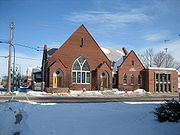 As of 2007 there are five church buildings in the Sycamore Historic District. When it was nominated to join the National Register there were seven church buildings within the district. One of those included is a residential structure that was utilized as a church when it was first constructed; the Arthur Stark House was once home to the Sycamore Universalist Church congregation. In the time since its listing, two churches have been destroyed or demolished. The Evangelical Church of St. John was destroyed by fire in 2004 and the United Methodist Church in Sycamore is no longer extant, replaced by a modern office building. The extant churches are the Old Congregational Church, First Baptist Church, St. Peter's Church, the Universalist Church/Stark House and St. Mary's Roman Catholic Church.
As of 2007 there are five church buildings in the Sycamore Historic District. When it was nominated to join the National Register there were seven church buildings within the district. One of those included is a residential structure that was utilized as a church when it was first constructed; the Arthur Stark House was once home to the Sycamore Universalist Church congregation. In the time since its listing, two churches have been destroyed or demolished. The Evangelical Church of St. John was destroyed by fire in 2004 and the United Methodist Church in Sycamore is no longer extant, replaced by a modern office building. The extant churches are the Old Congregational Church, First Baptist Church, St. Peter's Church, the Universalist Church/Stark House and St. Mary's Roman Catholic Church.
 The commercial buildings in the Sycamore Historic District, located in Sycamore, Illinois
The commercial buildings in the Sycamore Historic District, located in Sycamore, Illinois
, United States
are mostly located in and around the city's downtown. The largest concentration of commercial contributing properties to the historic district
are found along Illinois Route 64
as it passes through Sycamore. They include several buildings known as "blocks" which can consist of more than one adjacent and attached structure, as is the case with the Waterman Block, one of the Sycamore commercial buildings.
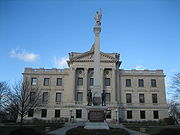 Possibly the gem of the Sycamore Historic District is the DeKalb County Courthouse. The Courthouse sits in the center of a square facing Illinois Route 64
Possibly the gem of the Sycamore Historic District is the DeKalb County Courthouse. The Courthouse sits in the center of a square facing Illinois Route 64
, directly across the north/south street, Main, from the Sycamore Public Library. It is a stunning example of Classical Revival architecture. The current structure was erected in 1905 being the third in a line of courthouses to serve DeKalb County.
for the estate of Frederick B. Townsend, his former home is the Queen Anne mansion that overlooks the garage property. Today it is home to a restaurant. After the building left private ownership the property was exploited for commercial use and became a gas station. Despite the years and the changes in function the building's historical character remains intact.
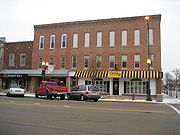
Though quite altered from its original state in the mid 19th century George's Block remains one of the more eye catching structures in the Historic District. The George's Block was constructed in 1857 and was then known as the James Block, after the owner Daniel P. James. James, a prominent citizen, lived in the nearby Jerkin-roofed
D. B. James House
, another contributing property. By the 1860s the James name was gone but the building was still known as a block. Many buildings of the period were known as blocks, usually multi-story and multi-business, the buildings contained retail and professional space or, in the case of George's Block, lecture halls or auditoriums. In the first year the building existed such famous men as Horace Greeley
, Charles Sumner
and Bayard Taylor
spoke there.
, 75% of the districts buildings. Many of the homes are associated with early Sycamore residents, usually prominent business leaders or politicians. Houses within the district are known by, either their street address or by a name associated with a prominent owner or builder. For most of the houses, the latter is true. Some of the more prominent homes include the Charles O. Boynton House
, the Frederick B. Townsend House
, David Syme House
and the Carlos Lattin House
.
Building in Sycamore is located along Illinois 64 (State Street), directly across the street from the Sycamore Public Library.
. The building was designed, in part, by architect Paul O. Moratz.
DeKalb County, Illinois
DeKalb County is a county located in the U.S. state of Illinois. According to the 2010 census, it has a population of 105,160, which is an increase of 18.2% from 88,969 in 2000. Its county seat is Sycamore. DeKalb County is part of the Chicago metropolitan statistical area.-History:DeKalb County...
, county seat, Sycamore
Sycamore, Illinois
Sycamore is a city in DeKalb County, Illinois, United States. It has a commercial district based and centered on Illinois Route 64. The population was 17,519 at the 2010 census, up from 12,020 at the 2000 census.-Early settlement:...
. The area includes historic buildings and a number of historical and Victorian
Victorian architecture
The term Victorian architecture refers collectively to several architectural styles employed predominantly during the middle and late 19th century. The period that it indicates may slightly overlap the actual reign, 20 June 1837 – 22 January 1901, of Queen Victoria. This represents the British and...
homes. Some significant structures are among those located within the Historic District including the DeKalb County Courthouse
DeKalb County Courthouse (Illinois)
The DeKalb County Courthouse is located in the county seat of DeKalb County, Illinois, U.S.A., the city of Sycamore. The Classical Revival structure sits on a square facing Illinois Route 64 as it passes through the city. The current courthouse was constructed in 1905 amid controversy over where...
and the Sycamore Public Library
Sycamore Public Library
The Sycamore Public Library, in Sycamore, Illinois, was erected in 1905 in the former location of Mansion House, Sycamore's oldest structure. Construction began in May of that year and the library officially opened to the public on Thanksgiving Day, 1905. The library joined the National Register of...
. The district has been listed on the National Register of Historic Places since May 2, 1978.
There are over 200 properties within the irregular boundaries of the Sycamore Historic District. Of those, 187 are considered contributing properties to the historic district, and 22 are non-contributing. Of all of the district's homes and buildings 75% fit within the historic district concept. Some of the major structures include several prominent Queen Anne style mansions, the Sycamore library, the DeKalb County Courthouse, and dozens of mid to late 19th century houses.
History
The 1966 National Historic Preservation Act, which created the National Register of Historic Places, empowered individual states to create review boards to function with the state historical preservation officer. Illinois did not create its historic preservation program until the early 1970s, under the direction of the Illinois Department of Conservation. The Department of Conservation dispatched field surveyors to all Illinois counties to find anything that might qualify for inclusion on the National Register of Historic Places.The field surveyor who traveled to Sycamore in 1973 found a large number of late 19th and 20th century examples of architecture that he recommended the establishment of a historic district. The mayor of Sycamore then appointed a citizens' committee to assist the state with the work involved in listing the district.
The residential areas within the district achieved their maturity before 1900, though Sycamore has grown considerably from the 3,330 or so that lived there from about 1900 until the 1970s most of the historic district remains intact as it was organized in 1978.
Boundaries
The Historic District is bounded by Somonauk Street on the west and Main Street on the east, a stretch of two blocks. On the north end the district is bounded by Page Street and extends to the end of South Main street. Main and Somonauk are both north/south roads while Page is an east/west street. The district also extends along State Street (Illinois Route 64Illinois Route 64
Illinois Route 64 is an east–west road in north-central Illinois. Its western terminus is at the Iowa state line, connecting with U.S. Route 52 and Iowa Highway 64 via the Savanna-Sabula Bridge at the Mississippi River west of Savanna...
) to the west until the 300 block. Somonauk Street is included through its 900 block. In addition section of Locust, Maple and California Streets are within the Sycamore Historic District. Other east/west streets also have portions included in the district, these are: Elm, High, Ottawa, Waterman and Lincoln.
The boundaries were drawn up by Robert Wagner, a Chicagoan who worked as a National Register assistant with the Illinois Department of Conservation. Wagner drew up the boundaries on the basis of "visual integrity.". This led to an irregular pattern of inclusion for the Sycamore Historic District. Often one side of the street will be in the district while the other side will not. In other cases, such as with the library or the U.S. Post Office
U.S. Post Office (Sycamore, Illinois)
The U.S. Post Office in Sycamore, Illinois is listed on the National Register of Historic Places as part of the Sycamore Historic District. The district was designated and listed in May 1978. It stands directly across the street from another key structure in the district, the Sycamore Public...
an arbitrary line was drawn with the sole purpose of including a specific structure.
Architecture

American Civil War
The American Civil War was a civil war fought in the United States of America. In response to the election of Abraham Lincoln as President of the United States, 11 southern slave states declared their secession from the United States and formed the Confederate States of America ; the other 25...
other styles began to dot the landscape in and around downtown Sycamore, Illinois
Sycamore, Illinois
Sycamore is a city in DeKalb County, Illinois, United States. It has a commercial district based and centered on Illinois Route 64. The population was 17,519 at the 2010 census, up from 12,020 at the 2000 census.-Early settlement:...
. Styles such as Italianate, Gothic Revival and Queen Anne can be found throughout the neighborhood. Government buildings and commercial buildings offer prime examples of Classical Revival architecture, a style showcased by the ornate DeKalb County Courthouse, Sycamore Public Library, U.S. Post Office and The National Bank & Trust Co. building. The current Sycamore Center, in the 300 block of State Street and once known as the Daniel Pierce Block, also exhibits. Classical Revival architecture.
Of the 226 properties within the Sycamore Historic District 40 are identified as "strongly contributing" to the overall character of the district. Twenty-one of those are ranked as the most significant structures in the district. The majority of the rest of the buildings date from 1860-1900.
Properties

226 properties are located within the Sycamore Historic District's 99 acres (400,639.1 m²). Of those properties, 187 are listed as contributing structures in the district while an additional 22 are non-contributing. Of all the homes and other buildings within the district a full 75% fit within the historic district concept.
Churches

Commercial buildings

Sycamore, Illinois
Sycamore is a city in DeKalb County, Illinois, United States. It has a commercial district based and centered on Illinois Route 64. The population was 17,519 at the 2010 census, up from 12,020 at the 2000 census.-Early settlement:...
, United States
United States
The United States of America is a federal constitutional republic comprising fifty states and a federal district...
are mostly located in and around the city's downtown. The largest concentration of commercial contributing properties to the historic district
Historic district
A historic district or heritage district is a section of a city which contains older buildings considered valuable for historical or architectural reasons. In some countries, historic districts receive legal protection from development....
are found along Illinois Route 64
Illinois Route 64
Illinois Route 64 is an east–west road in north-central Illinois. Its western terminus is at the Iowa state line, connecting with U.S. Route 52 and Iowa Highway 64 via the Savanna-Sabula Bridge at the Mississippi River west of Savanna...
as it passes through Sycamore. They include several buildings known as "blocks" which can consist of more than one adjacent and attached structure, as is the case with the Waterman Block, one of the Sycamore commercial buildings.
DeKalb County Courthouse

Illinois Route 64
Illinois Route 64 is an east–west road in north-central Illinois. Its western terminus is at the Iowa state line, connecting with U.S. Route 52 and Iowa Highway 64 via the Savanna-Sabula Bridge at the Mississippi River west of Savanna...
, directly across the north/south street, Main, from the Sycamore Public Library. It is a stunning example of Classical Revival architecture. The current structure was erected in 1905 being the third in a line of courthouses to serve DeKalb County.
Frederick Townsend Garage
This building on Main Street was originally a garage owned by Sycamore resident Frederick B. Townsend. Townsend's Queen Anne style home overlooks the lot from a small incline. The distinctive stone structure was constructed in 1906 for use as a garageGarage (house)
A residential garage is part of a home, or an associated building, designed or used for storing a vehicle or vehicles. In some places the term is used synonymously with "carport", though that term normally describes a structure that is not completely enclosed.- British residential garages:Those...
for the estate of Frederick B. Townsend, his former home is the Queen Anne mansion that overlooks the garage property. Today it is home to a restaurant. After the building left private ownership the property was exploited for commercial use and became a gas station. Despite the years and the changes in function the building's historical character remains intact.
George's Block

Though quite altered from its original state in the mid 19th century George's Block remains one of the more eye catching structures in the Historic District. The George's Block was constructed in 1857 and was then known as the James Block, after the owner Daniel P. James. James, a prominent citizen, lived in the nearby Jerkin-roofed
Jerkin
The word jerkin can mean:* Jerkin * Falconer's term for a male gyrfalcon* In architecture, a half-hip roof* Jerkin' - a hip hop dance movement that originated in Los Angeles....
D. B. James House
D. B. James House
The D. B. James House is located in Sycamore, Illinois and is part of the Sycamore Historic District. The district was entered on the National Register of Historic Places in 1978. The James House is one of 226 properties located within the district boundaries. It stands on the corner of Exchange...
, another contributing property. By the 1860s the James name was gone but the building was still known as a block. Many buildings of the period were known as blocks, usually multi-story and multi-business, the buildings contained retail and professional space or, in the case of George's Block, lecture halls or auditoriums. In the first year the building existed such famous men as Horace Greeley
Horace Greeley
Horace Greeley was an American newspaper editor, a founder of the Liberal Republican Party, a reformer, a politician, and an outspoken opponent of slavery...
, Charles Sumner
Charles Sumner
Charles Sumner was an American politician and senator from Massachusetts. An academic lawyer and a powerful orator, Sumner was the leader of the antislavery forces in Massachusetts and a leader of the Radical Republicans in the United States Senate during the American Civil War and Reconstruction,...
and Bayard Taylor
Bayard Taylor
Bayard Taylor was an American poet, literary critic, translator, and travel author.-Life and work:...
spoke there.
Houses
The houses in the Sycamore Historic District cross a variety of architectural styles and span from the 1830s to the early 20th century. There are 187 contributing properties within the historic districtHistoric district
A historic district or heritage district is a section of a city which contains older buildings considered valuable for historical or architectural reasons. In some countries, historic districts receive legal protection from development....
, 75% of the districts buildings. Many of the homes are associated with early Sycamore residents, usually prominent business leaders or politicians. Houses within the district are known by, either their street address or by a name associated with a prominent owner or builder. For most of the houses, the latter is true. Some of the more prominent homes include the Charles O. Boynton House
Charles O. Boynton House
The Charles O. Boynton House is located in the DeKalb County, Illinois, city of Sycamore. The home is part of the Sycamore Historic District which was designated and listed on the National Register of Historic Places in May 1978...
, the Frederick B. Townsend House
Frederick B. Townsend House
The Frederick B. Townsend House is located in the DeKalb County, Illinois county seat of Sycamore. The home is within the boundaries of the Sycamore Historic District. The district was designated and listed on the National Register of Historic Places in May 1978...
, David Syme House
David Syme House
The David Syme House is located in Sycamore, Illinois and is part of the Sycamore Historic District. The district was listed on the National Register of Historic Places in May 1978. The Queen Anne style home was constructed sometime around 1880.-History:...
and the Carlos Lattin House
Carlos Lattin House
The Carlos Lattin House was built by Sycamore, Illinois' first settler. It lies within the boundaries of the Sycamore Historic District and is listed as one of the contributing structures in the district...
.
U.S. Post Office
The U.S. Post OfficeU.S. Post Office (Sycamore, Illinois)
The U.S. Post Office in Sycamore, Illinois is listed on the National Register of Historic Places as part of the Sycamore Historic District. The district was designated and listed in May 1978. It stands directly across the street from another key structure in the district, the Sycamore Public...
Building in Sycamore is located along Illinois 64 (State Street), directly across the street from the Sycamore Public Library.
Sycamore Public Library
Sycamore Public Library, the only structure on the east side of Main Street, between State and Page Streets, that is included in the Sycamore Historic District. The library, still operational today, was constructed in 1905 with a combination of philanthropical gifts from different sources including Andrew CarnegieAndrew Carnegie
Andrew Carnegie was a Scottish-American industrialist, businessman, and entrepreneur who led the enormous expansion of the American steel industry in the late 19th century...
. The building was designed, in part, by architect Paul O. Moratz.

